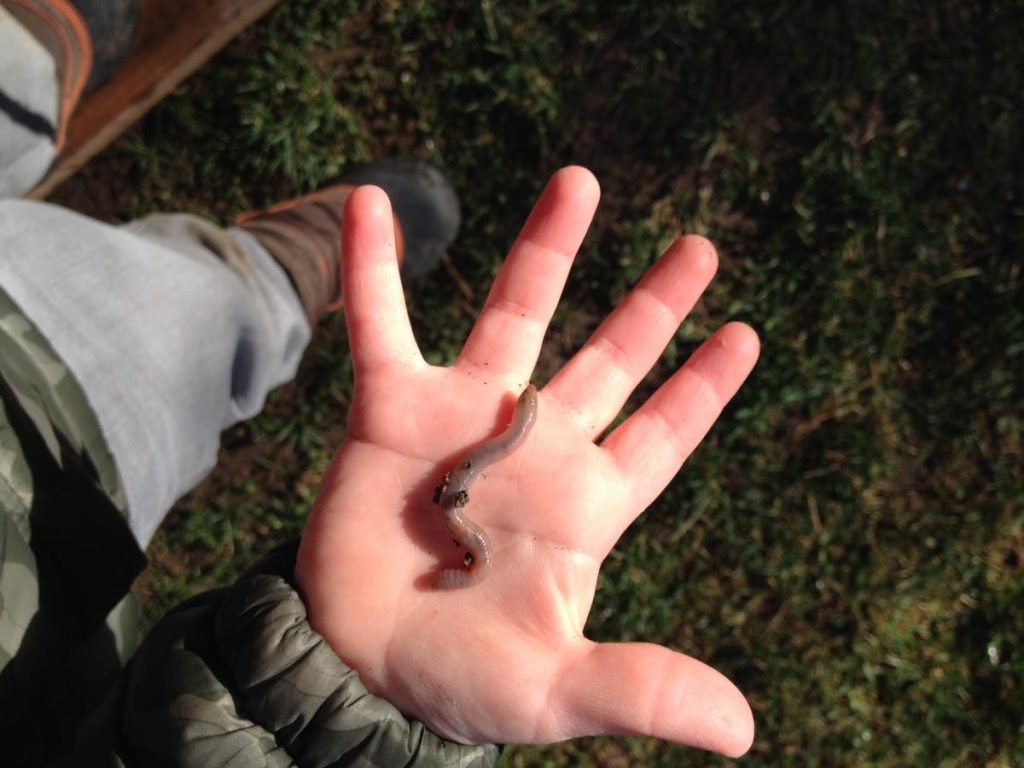I recently learned that one of the names for the March full moon is the “Worm Moon.” This is because the ground is softening, bringing the reappearance of earthworms and their castings, which also invites the return of robins. Here in Boulder, Colorado, at StarSong, we began the month of March with a good amount of lingering snow still on the ground, so I thought, “Surely, the worms won’t be returning just yet.” How wrong I was! As the snow melted in the week after the full moon, not only were there suddenly numerous crocuses blooming, but the children and I found not one, but several worms on the wet ground! Granted, some of them had “ow-ies” and were only a third or a half of a worm that must have been yanked apart by a greedy robin, but the worms were back! “Bug season” had begun!
A favorite spring and summer pastime of my little group of 1- to 4-year-olds is finding worms and other little bug creatures, like slugs, snails, roly-polies, and bees. We find the crawling bugs under stumps around the yard and under the bricks that line the edges of the garden spaces. Some of the children love to pick up the worms and sticky, slimy slugs and carry them around in their little hands. “A worm! A slug! Ooh, Ms. Julie, look!” There is such wonder and excitement in this whole scenario, with many reminders (from me) to be so gentle and careful with the little creatures, and to be sure to put them back in a safe place in the earth to rest.
One of my favorite early spring stories is Suzanne Down’s “Little Brown Bulb,” and the children are so excited as the crocuses emerge outside. Every morning we check the flowers that have come up, and there’s always something new! When we go back outside after lunch and the sun is higher in the sky, the flowers have fully opened to the sun and maybe the bees are visiting. We love to watch the bees, busy at work in each of the flowers, and thank them for making the honey for our tea. The children love to see the bees, and then laugh and run away.
My neighborhood is Boulder’s first “Bee Safe Neighborhood” (www.beesafeboulder.com), in which over half of the homes signed a pledge to avoid using neonicotinoids and systemic pesticides that kill bees, thus protecting bees and all of us from harmful chemicals. I share how we need the bees to make the honey and help the flowers and fruits of plants grow. I love dandelions and so do the bees! We watch them grow and the visiting bees. We pick the greens for the bunnies, Marigold and Bilbo, to eat (and taste them ourselves), and then we blow the dandelion “wishes” all over the place.
The children love “Here is the beehive” and “I’m busy, busy, busy, said the bee…” and all giggle when the “bees” in the fingerplays buzz around and visit and tickle each of them like a flower. We also watch the butterflies as they visit and flit through the yard. We have several sets of beautiful butterfly wings from Magic Cabin that the children can wear and be butterflies, too. “Fly little butterfly…”
While I am very much a beginner to biodynamic gardening, I do try. When my neighbor is rototilling his organic garden (chopping up worms) and I’m STILL double digging mine, I remember that process is so important for children, and they so love to dig! Therefore, the long process of digging in compost, taking turns with the shovels and learning to keep them down, with bystanders watching for worms so that we can move them out of harm’s way from our shovels to continue their work in the garden, is part of the beauty of it. It takes longer to actually get anything planted, but hey, we’ve got time and space together. Last year, the zucchini starter plant that I got from a local, biodynamic farm was planted on a “fruit day,” after spraying the biodynamic Field & Garden Spray, and all I can say is, “Wow!” I’ve never seen a plant like it! I know zucchinis can be prolific, but it yielded like crazy, and honestly, the plant itself appeared to be reaching up to the heavens in an “Ah” gesture. So beautiful!
I’d like to start more seeds, but having plants that are already started works best for me at the moment. We’re always striving, right? So after the digging comes the watering (watering cans are such fun to fill and pour!)…and the waiting. We still look for worms every day. The children love checking on the zucchinis, watching the growth and the bees in the blossoms, helping to carry in the harvest, and also checking for and nibbling the ripe cherry tomatoes. Cherry tomatoes are perfect for a children’s garden–just right for little hands to pick.
We prepare and tend the garden, and observe it all. So much growth and insect activity happens as winter turns into spring, spring into summer, and summer into fall. We watch in wonder and joy until it finally becomes too cold again and the insects all retreat for another winter, and the garden goes to sleep again.
Julie Zacharias is in her third year as the owner/primary caregiver of StarSong LifeWays Child Care, a LifeWays Representative program in her home in north Boulder, Colorado, for children ages 1 to 4.
